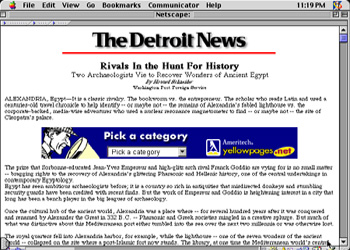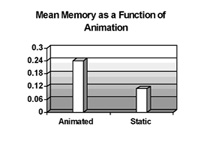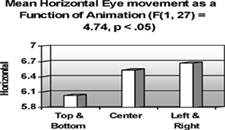Media Effects Research Lab - Research Archive
Visual orientation and memory for web advertising:
Student Researcher(s)
Nokon Heo ( Candidate);
Faculty Supervisor
FOR A COMPLETE REPORT OF THIS RESEARCH, SEE:
Heo, N., & Sundar, S. S. (2000, June). Visual orientation and memory for web advertising: A study of animation and position effects. Paper presented to the Information Systems Division at the 50th annual conference of the International Communication Association (ICA), Acapulco, Mexico.
INTRODUCTION
This study investigated psychological effects of animation and ad position within the context of online advertising. The study examined the effects of ad animation and position on Internet viewers' visual orientation toward and memory of ads. Visual orientation was operationalized by recording participants' eye movements via Electrooculargraphy (EOG) during their exposure to the online stimuli.
RESEARCH QUESTIONS AND HYPOTHESES
We asked the following research questions:
RQ1: What is the relationship between ad position and visual orientation for the ad?
RQ2: What is the relationship between ad position and memory for the ad?
Hypotheses
"Motion effect theories" suggest that moving images stimulate more "visual orienting responses" than still images.
"Distinctiveness theories of motion" state that animation or moving objects "pop-up" in the early visual information processing to capture viewers' immediate attention.
These two theories lead to the following hypothesis:
H1: Animated ads will generate greater visual orientation than static ads.
"Dual-coding theory" suggests that any stored information in long-term memory that consists of vivid visual images coupled with verbal information facilitates retrieval of information because they leave more available memory traces. This leads to the following hypothesis:
H2: Animated ads are more likely to be remembered than static ads.
METHOD
Thirty-two participants were randomly assigned to one of four orders of a 2 (animation) x 5 (position) within-participants factorial experiment. Ten separate online news pages, each featuring a news story and an ad, were used as stimulus material. Each ad was positioned at one of the five positions (top, bottom, center, sides), and half of ads were animated while the remaining half were static.

A total of six electrodes were places on participants' face to measure ocular movement. Participants were exposed to 10 news sites for 15 seconds each automatically refreshed by the computer. After two more written instruction, participants read the first news page. After all 10 sites, participants' eye movements were calibrated. After the calibration, participants completed a paper-and-pencil questionnaire.
RESULTS
H1. Not supported. Animated ads did not generate greater visual orientation than static ads.
H2. Supported. Animated ads were remembered better than static ads.

The results also revealed that visual orientation was highest when the ads were positioned to the sides (compared to ads positioned at the top, bottom, or center). The relationship between ad position and memory approached significance such that participants exposed to ads placed at the sides had higher memory scores than those participants exposed to ads placed at the top, bottom, or center.

CONCLUSION
The findings from the study suggest that ad animation and position are important non-content related ad characteristics that can determine the effectiveness of web advertising. Physiological measure of visual orientation measured by EOG can be an alternative measurement tool for advertising effectiveness, as evidenced by a positive relationship between EOG and ad memory.
For more details regarding the study contact
Dr. S. Shyam Sundar by e-mail at sss12@psu.edu or by telephone at (814) 865-2173

